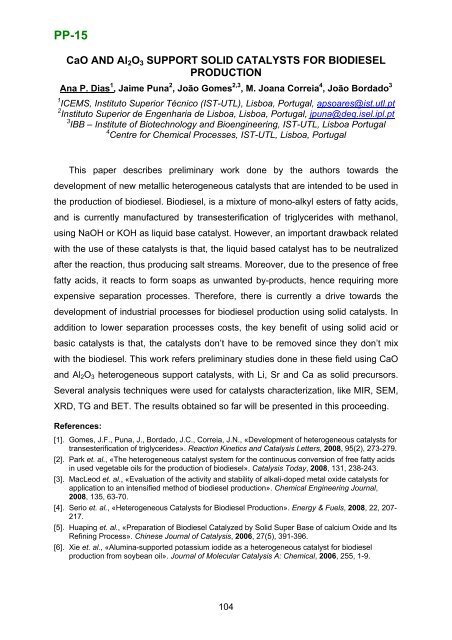Boreskov Institute of Catalysis SB RAS, Novosibirsk, Russia
Boreskov Institute of Catalysis SB RAS, Novosibirsk, Russia
Boreskov Institute of Catalysis SB RAS, Novosibirsk, Russia
- No tags were found...
You also want an ePaper? Increase the reach of your titles
YUMPU automatically turns print PDFs into web optimized ePapers that Google loves.
PP-15CaO AND Al 2 O 3 SUPPORT SOLID CATALYSTS FOR BIODIESELPRODUCTIONAna P. Dias 1 , Jaime Puna 2 , João Gomes 2,3 , M. Joana Correia 4 , João Bordado 31 ICEMS, Instituto Superior Técnico (IST-UTL), Lisboa, Portugal, apsoares@ist.utl.pt2 Instituto Superior de Engenharia de Lisboa, Lisboa, Portugal, jpuna@deq.isel.ipl.pt3 IBB – <strong>Institute</strong> <strong>of</strong> Biotechnology and Bioengineering, IST-UTL, Lisboa Portugal4 Centre for Chemical Processes, IST-UTL, Lisboa, PortugalThis paper describes preliminary work done by the authors towards thedevelopment <strong>of</strong> new metallic heterogeneous catalysts that are intended to be used inthe production <strong>of</strong> biodiesel. Biodiesel, is a mixture <strong>of</strong> mono-alkyl esters <strong>of</strong> fatty acids,and is currently manufactured by transesterification <strong>of</strong> triglycerides with methanol,using NaOH or KOH as liquid base catalyst. However, an important drawback relatedwith the use <strong>of</strong> these catalysts is that, the liquid based catalyst has to be neutralizedafter the reaction, thus producing salt streams. Moreover, due to the presence <strong>of</strong> freefatty acids, it reacts to form soaps as unwanted by-products, hence requiring moreexpensive separation processes. Therefore, there is currently a drive towards thedevelopment <strong>of</strong> industrial processes for biodiesel production using solid catalysts. Inaddition to lower separation processes costs, the key benefit <strong>of</strong> using solid acid orbasic catalysts is that, the catalysts don’t have to be removed since they don’t mixwith the biodiesel. This work refers preliminary studies done in these field using CaOand Al 2 O 3 heterogeneous support catalysts, with Li, Sr and Ca as solid precursors.Several analysis techniques were used for catalysts characterization, like MIR, SEM,XRD, TG and BET. The results obtained so far will be presented in this proceeding.References:[1]. Gomes, J.F., Puna, J., Bordado, J.C., Correia, J.N., «Development <strong>of</strong> heterogeneous catalysts fortransesterification <strong>of</strong> triglycerides». Reaction Kinetics and <strong>Catalysis</strong> Letters, 2008, 95(2), 273-279.[2]. Park et. al., «The heterogeneous catalyst system for the continuous conversion <strong>of</strong> free fatty acidsin used vegetable oils for the production <strong>of</strong> biodiesel». <strong>Catalysis</strong> Today, 2008, 131, 238-243.[3]. MacLeod et. al., «Evaluation <strong>of</strong> the activity and stability <strong>of</strong> alkali-doped metal oxide catalysts forapplication to an intensified method <strong>of</strong> biodiesel production». Chemical Engineering Journal,2008, 135, 63-70.[4]. Serio et. al., «Heterogeneous Catalysts for Biodiesel Production». Energy & Fuels, 2008, 22, 207-217.[5]. Huaping et. al., «Preparation <strong>of</strong> Biodiesel Catalyzed by Solid Super Base <strong>of</strong> calcium Oxide and ItsRefining Process». Chinese Journal <strong>of</strong> <strong>Catalysis</strong>, 2006, 27(5), 391-396.[6]. Xie et. al., «Alumina-supported potassium iodide as a heterogeneous catalyst for biodieselproduction from soybean oil». Journal <strong>of</strong> Molecular <strong>Catalysis</strong> A: Chemical, 2006, 255, 1-9.104
















